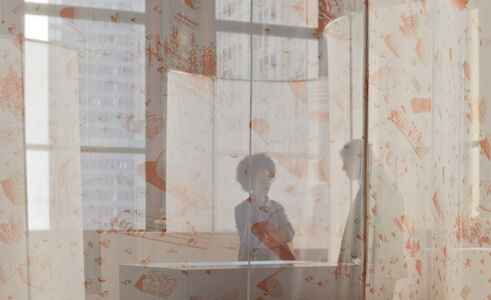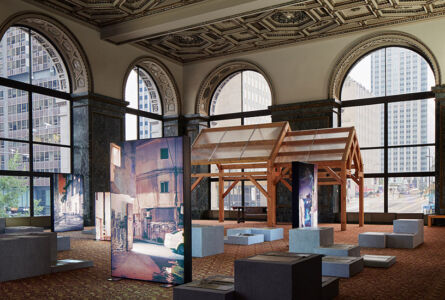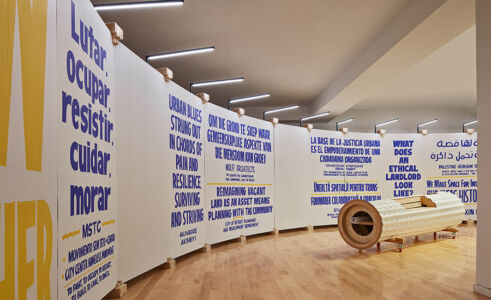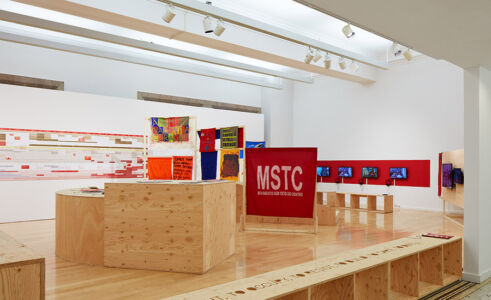Curated and accompanied by a catalogue, . . . And Other Such Stories, edited by Yesomi Umolu, Sepake Angiama, Paulo Tavares, the third Chicago Architecture Biennial opened at the Chicago Cultural Center on 19 September 2019, and remains open until 5 January 2020.
Arrayed over three floors of the spectacular Beaux-Arts Chicago Cultural Center (the former city library and memorial hall built in 1897 by the Shepley, Rutan and Coolidge, architects in Boston, and converted in 1977 into the first free municipal cultural center in the USA), the Biennial intends to “address social inequities and the erasure of indigenous landscapes and narratives.” Marked by the double sins of colonialism and slavery, architecture and city planning are called to social action and reparation of these long-standing inequities. In practical terms, this program involves trenchant criticism of current fossil extraction methods, mismanagement of large swaths of land rich in natural resources, colonialism, exploitation of human labor, and the consequent undermining of the social covenant. Significantly, this includes the charges of forced labor in the sourcing and placement of the lavish imported materials that adorn this deeply historicist building, such as Bedford Blue limestone, Tennessee granite, Vermont green-veined marble, Knoxville pink marble, Tiffany glass, mosaics, bronze, Carrara marble, and Connemara green marble (as well as imported ideas, from celebrated Venetian sites such as the Bridge of Sighs and the Doge’s Palace). In the words of Roberta Feldman, Professor Emerita of Architecture, Director Emerita of the City Design Center at the University of Illinois, and a widely-known activist for housing equity, “the Chicago Architecture Biennial addresses critical issues of racial and class identities and inequities through powerful and impactful installations, but the connections to and challenges for architectural interventions are, by and large, ambiguous or unexplored.” Approaching the Biennial’s contributions from another perspective, Shiben Banerji, Professor of architectural history at the School of the Art Institute, observes that “the Biennial is an unbridled celebration of transnational civil society as a vehicle for social development, as most exhibitors appear to have given up on the idea of the state as an agent of social transformation,” while believing still that “architecture should ignite society’s capacity to imagine a better world.”
The exhibitions are punctuated by reminders, mostly as plaques and place markers, that the Chicago Cultural Center (like Chicago itself) stands on land robbed from its native inhabitants, and that the numerous and lavish building materials that constitute it were obtained through slave labor. The two largest exhibition spaces are similar in their focused devotion, respectively, to issues of marginality and exploited minorities, and extraction and preservation of natural mineral resources.
Great effort is expended on the design of the installations, which stand in for architectural display. Most of the exhibits themselves deal with housing, the minima of architectural research, and with environmental destruction by exploitative, or non-existent, infrastructural planning. They are divided between the detailed specificity of the house and the planetary scale of environmental destruction. I would summarize the overall structure of the Biennial exhibition as huts and sprawl. Both have been actively studied by architects in the past century, but according to this curated exhibition many considerations must still be explored.
Hut-like installations punctuate the sequence of exhibits. The Gun Violence Memorial project by MASS Design Groupoffers a startling beginning to the Biennial. This ‘opening salvo’ alerts the visitor to gun violence in the USA through four glass huts, transparent cabins fabricated from gridded, see-through walls that constitute the ‘building blocks’ to be filled with mementoes of the slaughtered. The shelves of the huts’ enclosures contain the stories and souvenir objects of mass murder and other random killings blamed on the availability of firearms in this country. Since the grid is uniform, the commemorated killings and their objects democratize and flatten the generalized hatred of the random mass shootings and the specificity of gang and passion crimes.
The Chicago cabins of violence are later in the exhibit contrasted with the Lapland ‘primitive’ hut, an installation made of native materials such as dried halibut stomachs stretched on wooden frames, and anchored by a bound architectural element that reflects the artist Joar Nango’s take on architecture as a gagging device.
More huts follow. The Great Lakes Water School by Oscar Tuazonis an expressive angular wood shed surrounded by sun-heated barrels of water that naturally absorb and then radiate heat. The Arte Povera-like ‘fire’ hut–with a simulated burning center–built of found materials by Santiago Xis a vivid and dangerous reminder of the elementary function of building. Indigenous geometries form the basis of the bent-wood hut designed by Tanya Lukin Linklaterand Tiffany Shaw-Collinge, the most sculptural of the exhibits on view. The great rough skeletal cabin, like the bent-wood hut and also reminiscent of Arte Povera’s use of found objects, by Sweet Water Foundation, is an imposing presence, recalls in its form slave cabins on American plantations but over-scaled in its expression, a vivid contrast to inherited architectural practices, under the ornate ceiling of the Center’s most elaborately decorated exhibition space.
The interest in larger-scale housing issues is taken up by descriptive installations of community-activism through squatting in Brazil (São Paolo), sprawl in Chile (Santiago), and sanitation and equity in India (Mumbai). For example, Alejandra Celedónlinks the carpet-like sprawl of Santiago (represented through use of mirrors in a pool-like enclosure) to the insidious influence of the free-market capitalism theorized by the Chicago school of economics. The scarcity of housing and the degradation of the urban environment are posited as the counterpart to extraction projects in the ‘Museum of Oil’ installation by Territorial Agency, whose large, threatening, leaning panels effectively exhort the attention of the viewer; the message ‘keep oil in the ground’ is effectively illustrated with impressive satellite views. Numerous panels of text and illuminated plans on large pedestals, by Somatic Collective, document how the extraction of water, oil, gold, copper and iron trounces Brazil’s environment, rather than benefitting the poorly-housed population.
The large-scale displays offering trenchant critiques of reckless environmental management, and the small huts expressively conveying detailed loss and negligence, are linked through a series of conversation circles. The one at the main entry of the Biennial, byLand Acknowledgement, urges visitors to consider the land and the specific place on which the buildings stand, issuing a call to activism that would recognize openly and regularly (as it does, for example, in Australian public cultural events) the damage inflicted upon the native populations by colonizers. The “Anarchitectural Library” of Adrian Blackwelloffers his personal collection of books and pamphlets for visitors’ debates, while the curved walls enclosing the conversation pit of ConstructLab call visitors to active opposition and rebellion against the status quo.
Two sculptural interventions stand out in this series of installations energetically competing for the attention and active involvement of visitors. Walter Hood’s spiky wooden ‘trees’ occupy the large internal court of the building, and withstand easily the blustery curve of the enclosing wall, while Maria Gaspar’s actual wall-large, grey and abraided-is an existential and silently eloquent call for architectural action.

































